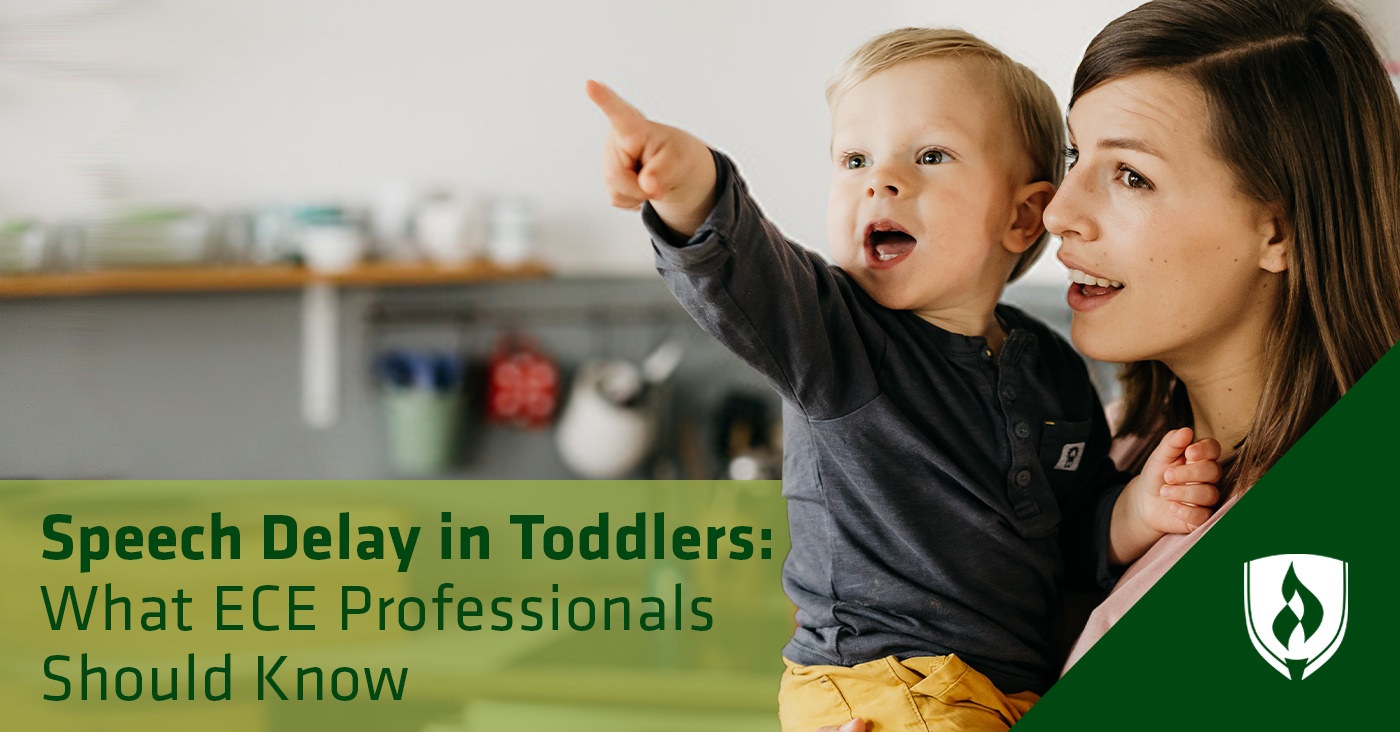
Early childhood educators have plenty to do in their day. They’re responsible for planning age-appropriate activities for their students, serving nutritious meals and snacks and keeping kids happy and safe. Also on the list: observing children to make sure they’re meeting developmental milestones.
One of those milestones is language development. Most people think of language development in early childhood as something that happens naturally as babies hear their caregivers’ speech and begin to imitate it by babbling. But speech delays and other language disorders are more common than you might think, with eight to nine percent of young children having a speech sound disorder, according to the U.S. Department of Health and Human Services.1
Early childhood educators are in the perfect position to be on the lookout for speech delays and take action if they notice a child isn’t meeting language milestones. Join us as we explore what ECE professionals need to know about childhood language development.
What is a speech delay?
The terms “speech” and “language” are often used interchangeably, but there is a slight difference when it comes to developmental milestones. According to Johns Hopkins, speech delays are when a child uses words to express their ideas, but they’re difficult to understand. A language delay refers more to a child’s ability to communicate overall—so they might be able to speak clearly, but they can only say a few words.2
The age at which children reach various language milestones can vary quite a bit—and in many cases, that’s completely normal. This can make identifying a true speech or language delay tricky.
“Because of the important role speech-language development plays in the early childhood years, it is better to be proactive if you have any concerns rather than waiting to see whether issues go away on their own,” says neuropsychologist Dr. Emily Papazoglou.
Although pediatricians will screen for speech delays at well-child visits, those checkups can be too far apart to catch missed milestones early on. Early childhood professionals, on the other hand, work with children on a daily basis and are in the perfect position to notice if their language development isn’t on track.
What ECE professionals should know about delayed speech development
It may seem cute when a young child speaks with a lisp or other difficult-to-understand speech, but language delays can have serious consequences if they’re not addressed. “Issues in this area can affect development more broadly, including social skills and mastery of early academic skills,” Papazoglou says.
Speech and language delays can be caused by a variety of underlying issues, which is one of the reasons early intervention is so important. According to Johns Hopkins, language delays can be caused by problems with the tongue or palate, chronic ear infections and even brain issues that create difficulty controlling the mouth.2
Speech-language delays can also cause behavior issues in young children. “Children that have a way to communicate their needs and wants are less stressed and have fewer outbursts of crying or other unwanted behaviors,” says Traci Bean, speech-language pathologist and owner of Total Education Solutions.
Delays in language development can have an impact on many aspects of a child’s life, which is why ECE professionals need to be aware of the signs that there might be a problem.
Signs that a child may have a language delay
The warning signs of a speech delay are typically broken down by age. Use these standards from Johns Hopkins as general guidelines that something may be amiss.2
- By 12 months: Child doesn’t communicate in gestures, like reaching, waving or pointing.
- By 18 months: Child struggles to imitate sounds and still prefers gestures over verbal sounds to communicate.
- By 2 years: Child can only communicate their immediate needs, can only repeat sounds after an adult or can’t understand simple directions.
- By 4 years: It’s still difficult to understand the child, especially by people who don’t know them well.
There are also a few general warning signs to keep in mind. Papazoglou recommends looking for any signs that a child is struggling to understand or communicate with others. This could include repeatedly not following directions or not playing appropriately. “Children [with a speech-language issue] may also rely very heavily on gestures, seem withdrawn or get frustrated if they are having difficulty communicating.”
Steps to take if you suspect a child has a speech delay
It’s important to remember that although these signs can be indicators of a speech or language delay, they’re not a guarantee that there’s a problem. “Many children who present with characteristics of a speech delay do not actually have one,” Bean says.
ECE professionals who suspect a speech delay should talk with the child’s family and connect them with specialists who can complete a formal assessment. Bean recommends arranging a private meeting with the family as well as including documentation that explains what you’ve observed and why you suspect a problem.
“Hearing that their child may have a delay can be stressful,” Bean says. “It will also help to print out some developmental guidelines and have some resources a parent can refer to after the shock wears off.”
After speaking to parents, your next steps will likely include a referral for assessment. Families can contact their school district to let them know of your concerns and schedule a free assessment with a professional.
Ways for ECE professionals to encourage language development
Whether a child has a diagnosable speech delay or is simply a late talker, all early childhood educators can take steps to encourage strong language development in their care setting.
The most basic step is to model plenty of talking and singing with the children in their care, no matter how young. Believe it or not, the first six months of a baby’s life are the most important to their language development!1 “It doesn’t matter what you talk about. They will watch your mouth, listen to your intonation and observe your body language,” Bean says.
Papazoglou recommends making the environment as language rich as possible, such as narrating your actions or describing what the child is doing as they play. “If a child is finding it difficult to request something, provide them with a model of what to say and then encourage them to repeat it back.”
ECE providers can also involve families in the important work of language development. Bean recommends modeling for families how to encourage responses from children who are struggling to find a word or teaching families to use gestures or “baby sign language” with their children who aren’t yet speaking.
Supporting children through an ECE career
Language development in early childhood is just one milestone to look for, but there are other red flags besides speech delays. ECE providers support every aspect of a child’s growth, from motor skills to social-emotional development.
Learn more about the many ways ECE professionals support children at young ages by reading up on these Early Childhood Development Milestones: What You Should Know.
Additionally, understanding the principles of social and emotional learning (SEL) is essential in the field of early childhood education. Explore our article on "What Is SEL?" to gain insights into this crucial aspect of fostering child development and well-being.
1National Institute on Deafness and Other Communication Disorders (NIDCD), [accessed October 2020], https://www.nidcd.nih.gov/health/statistics/quick-statistics-voice-speech-language
2Johns Hopkins All Children’s Hospital, [accessed October 2020], https://www.hopkinsallchildrens.org/Patients-Families/Health-Library/HealthDocNew/Delayed-Speech-or-Language-Development




